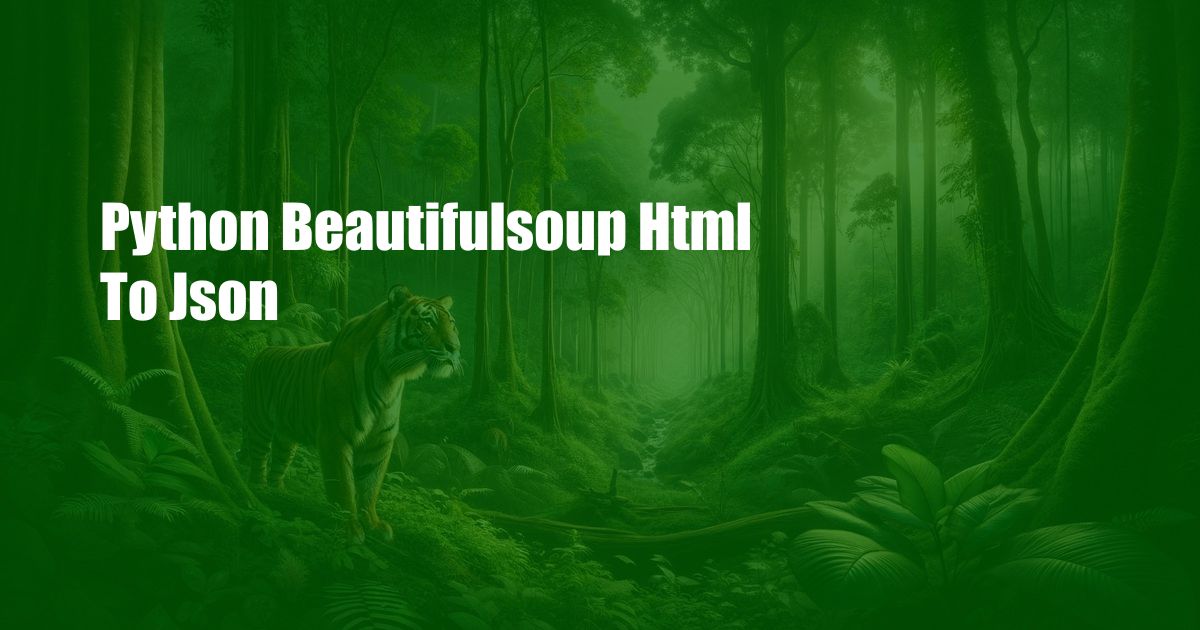
Python BeautifulSoup: Converting HTML to JSON with Ease
As a data enthusiast, I’ve encountered countless instances where I needed to extract meaningful data from HTML documents. One of my go-to tools for this task is BeautifulSoup, a Python library that empowers developers to parse, navigate, and modify HTML and XML documents with remarkable efficiency. In this comprehensive guide, we’ll embark on a journey to unravel the intricacies of converting HTML to JSON using BeautifulSoup, unlocking new horizons for data manipulation and analysis.
Parsing HTML with BeautifulSoup
BeautifulSoup is a versatile library that provides an intuitive and powerful interface for parsing HTML documents. It leverages a soup object to represent the HTML content, allowing us to navigate its structure using Pythonic methods and attributes. This parsing prowess opens doors to numerous data manipulation possibilities.
Converting HTML to JSON
Often, we encounter situations where we need to convert HTML to JSON for further processing or data exchange. BeautifulSoup facilitates this conversion with remarkable ease. By traversing the HTML document’s DOM tree, we can extract data from specific tags, attributes, or even the entire document structure. This extracted data can then be serialized into a JSON string, providing a structured and interoperable data format.
Step-by-Step Conversion Process
The conversion process from HTML to JSON involves a series of steps:
- Import BeautifulSoup: Begin by importing the BeautifulSoup library into your Python script.
- Parse the HTML: Use BeautifulSoup to parse the HTML document and create a soup object.
- Traverse the DOM Tree: Navigate the HTML document’s DOM tree to identify the desired data.
- Extract Data: Extract data from specific tags, attributes, or the entire document structure.
- Serialize to JSON: Convert the extracted data into a JSON string using the json library.
Latest Trends and Developments
The realm of HTML parsing with BeautifulSoup is constantly evolving, with new features and capabilities emerging to enhance data extraction and manipulation capabilities. Recent developments include:
- Improved CSS selectors: Enhanced CSS selector support allows for more precise and efficient data retrieval from HTML documents.
- Async parsing: Asynchronous parsing techniques enable parallel processing of large HTML documents, significantly improving performance.
- Integration with other libraries: BeautifulSoup seamlessly integrates with other popular Python libraries such as Pandas and NumPy, facilitating seamless data analysis and visualization workflows.
Tips and Expert Advice for Successful HTML-to-JSON Conversion
To excel at converting HTML to JSON with BeautifulSoup, consider these tips from experienced practitioners:
- Use CSS selectors: Leverage the power of CSS selectors for precise navigation and data retrieval.
- Handle complex structures: BeautifulSoup effectively handles complex HTML structures, making data extraction from intricate documents a breeze.
- Familiarize yourself with the DOM tree: Understand the structure and hierarchy of the HTML document to optimize data extraction.
- Test and validate: Thoroughly test and validate your converted JSON data to ensure accuracy and consistency.
Frequently Asked Questions
Q: What is the purpose of converting HTML to JSON?
A: JSON provides a structured and interoperable data format, making it suitable for data exchange, storage, and analysis. Converting HTML to JSON facilitates data extraction and integration with other systems.
Q: Can BeautifulSoup convert any HTML document to JSON?
A: BeautifulSoup can handle a wide variety of HTML documents. However, if the HTML is malformed or has structural issues, conversion may not be possible.
Conclusion
In this comprehensive guide, we have navigated the intricacies of converting HTML to JSON using BeautifulSoup. By following the step-by-step process, leveraging the latest trends and developments, and adhering to best practices, you can unlock the potential of data extraction and manipulation from HTML documents.
Are you ready to embark on your journey of converting HTML to JSON? Share your experiences and insights in the comments section below!

 Hogki.com Trusted Information and Education News Media
Hogki.com Trusted Information and Education News Media